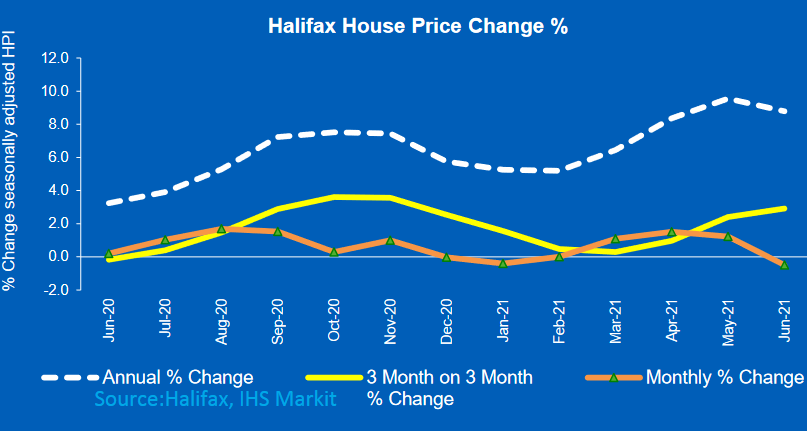
9:04 AM, 7th July 2021, About 3 years ago
Text Size
The latest Halifax House Price Index reports annual price inflation of 8.8% compared to 9.6% in May and the average UK property price now stands at £260,358.
Regions and nations house prices:
Whilst the two Midlands regions and Greater London saw slightly slower annual price gains compared to May, all the other regions and nations saw a strengthening of inflation.
Wales (12.0%) continues to lead the way on annual house price growth, registering its strongestperformance since April 2005, whilst Northern Ireland (11.5%), the North West (11.5%), Yorkshire and Humberside (10.9%) and Scotland (10.4%) all registered double-digit gains.
For Northern Ireland and Scotland, the annual price rises were the highest recorded since late 2007, while for the North West and Yorkshire, inflation was the strongest since early 2005.
At the other end of the scale, the South of England continues to lag somewhat behind the rest of the country (Eastern England and the South East recording inflation rates of around 7%).
However, once again its Greater London that is somewhat of an outlier: house price inflation there was just 2.9% year-on-year, though as we’ve noted previously, there are several unique factors likely to be weighing on the capital’s property market.
Russell Galley, Managing Director, Halifax, said: “The average UK house price slipped by –0.5% in June, the first monthly fall since January. As a result annual house price inflation also eased back slightly from May’s 14-year high of +9.6% to stand at +8.8% in June. It is important to put such a moderate decrease in context, with average prices still more than £21,000 higher than this time last year, following a broadly unprecedented period of gains.
“With the stamp duty holiday now being phased out, it was predicted the market might start to lose some steam entering the latter half of the year, and it’s unlikely that those with mortgages approved in the early months of summer expected to benefit from the maximum tax break, given the time needed to complete transactions.
“That said, with the tapered approach, those purchasing at the current average price of £260,358 would still only pay about £500 in stamp duty at today’s rates, increasing to around £3,000 when things return to normal from the start of October.
“Government support measures over the last year have helped to boost demand, particularly amongst buyers searching for larger family homes at the upper end of the market. Indeed, the average price of a detached home has risen faster than any other property type over the past 12 months, up by more than 10% or almost £47,000 in cash terms. At a cost of over half a million pounds, they are now £200,000 more expensive than the typical semi-detached house.
“That power of homemovers to drive the market, as people look to find properties with more space, spurred on by increased time spent at home during the pandemic, won’t fade entirely as the economy recovers. Coupled with buyers chasing the relatively small number of available properties, and continued low borrowing rates, it’s a trend which can sustain high average prices for some time to come.
“However, we would still expect annual growth to have slowed somewhat more by the end of the year, with unemployment expected to edge higher as job support measures unwind, and the peak of buyer demand now likely to have passed.”
Previous Article
UK rents rise overall with the London the exceptionNext Article
Sales (demand) still outstripping new stock (supply)